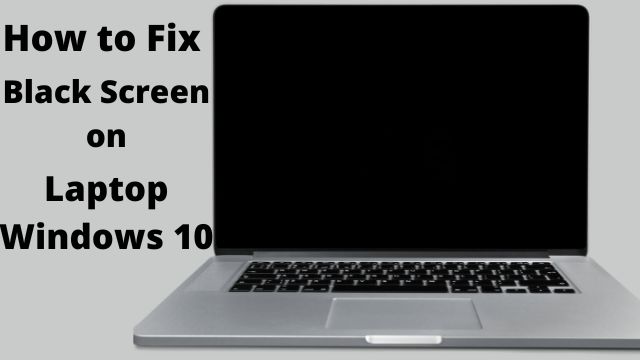
Is your Laptop randomly flickering to a blank screen during the day or displaying the feared black screen of death? Learn how to fix black screen on laptop Windows 10 , as well as how PC optimization software can assist you in avoiding a black screen altogether.
What is the black screen?
When a serious issue compels the operating system to shut down, your computer will display the Windows black screen, sometimes known as the black screen of death. You may encounter the blank screen while signing in, updating software, or even in the middle of a task.
What causes the black screen?
A critical issue in your computer’s operating system that results in the “black screen of death” can be brought on by a problematic device driver, a flaw in the hardware, or a Windows software bug. Finding the source of the black screen is not always simple, but it is typically fixable.
Here are some common causes of a Windows 10 black screen:
- A Windows update gone wrong
- A faulty startup application
- Outdated or faulty drivers
- Connection issues between your PC and monitor
- Software defects
- Hardware defects
- Problems with your graphics card
- Loose cables connected to your PC or laptop
We’ll walk you through each step needed to identify and resolve the problems causing the black screen of death, both before and after logging in, in the section below.
If you get a completely black screen prior to logging in, there is likely a hardware problem or a faulty device driver to blame. If the blank screen appears after logging in, Windows is probably malfunctioning. This could be due to a problematic Windows 10 update or an issue with an installed application.
Before signing in, we’ll first discuss options for a black screen. After that, we’ll talk about how to fix a black screen of death that occurs after logging in.
How to Fix Black Screen on Laptop Windows 10
Solutions for a black screen before logging in
- Check your cables and connections
- Optimize your startup applications
- Unplug all unnecessary accessories
- Launch a Windows repair
- Try a BIOS/UEFI reset and check the boot order
- Roll back or update all drivers in Safe Mode
- Boot into Safe Mode
Check your cables and connections
If everything is running smoothly until your computer suddenly displays a blank screen, there may be an issue with your monitor or computer cables. How to inspect your wires and other crucial connections is provided below:
- Unplug and reconnect your video cables
- Try a different monitor
- Try a different cable
Unplug and reconnect your video cables
Your HDMI, DVI, DisplayPort, and VGA visual wires should all be disconnected and reconnected. Blow inside the ports while you’re at it to remove any dust or other debris that might have become lodged there.
Try a different monitor
Another factor that may contribute to a black screen on your monitor is a malfunctioning or incorrectly configured display. If you have access to another display, try connecting to it. Or, switch to your TV instead of your monitor (or vice versa).
Try a different cable
Cables that are often plugged in and out wear out over time and eventually break. If you use a laptop and an external monitor, it happens frequently.
Try connecting an alternative video cable, such as the one from your TV, that you are certain functions properly to see if that resolves the black screen issue. It’s time to purchase a new computer cable if the cable connection results in an image rather than a completely blank screen.
A resolution and monitor mismatch could be the blame for the blank screen. For instance, a projector unable to display the high resolution may not be compatible with a gaming PC.
Try connecting your Windows 10 computer to a conventional monitor if the projector connection causes a “boot error” to appear. If images appear normally on the ordinary monitor, the projector’s inability to display a very low resolution is most likely the cause of your issue.
Optimize your startup applications
If you only sometimes experience a black screen, you can speed up boot time by turning off several starting components. All unnecessary programmes can be disabled and put to sleep automatically.
There is a built-in sleep mode that allows you to maximize the use of your RAM and CPU while having additional resources available at startup.
Unplug all unnecessary accessories
External hard drives, USB connections, Wi-Fi antennae, and VR headsets might occasionally interfere with a device’s ability to boot.
If your laptop’s screen remains black after startup, unhook everything that isn’t absolutely necessary for your PC to function; simply keep your keyboard, mouse, and monitor connected. Then, restart your computer.
Try eliminating all extraneous parts from a larger desktop computer, such as sound cards and extra RAM sticks. You can also replace the graphics card and entirely upgrade your RAM if that doesn’t work.
Launch a Windows repair
You should restart your computer numerous times if it starts up to a blank screen. The Windows Startup Automatic Repair screen ought should automatically open after performing this several times.
- Tap Restart.
- Go to Advanced settings
- Choose System Restore if it doesn’t resolve the black screen problem.
- Create a bootable Windows 10 drive
- Plug it in
- Apply the disk-boot advice from above to ensure your computer starts from the USB drive if the Windows repair doesn’t work.
- Choose a system restore point that is a few days old after the system restore programme has launched.
Then, as Windows restores all necessary files and puts everything back in working order, press Next. You might occasionally need to reinstall a programme or update.
Try a BIOS/UEFI reset and check the boot order
Older PCs are powered by BIOS, whereas newer versions are powered by UEFI. Basic hardware setting is governed by BIOS/UEFI, which also ensures that the operating system launches.
Try restoring to the default settings if you’re experiencing a black screen of death.
Here is how to restart the BIOS or UEFI:
- Hit the power button to restart your computer after turning it off.
- You’ll be prompted to press a specific key at startup to enter setup (usually F2 or the DEL key).
- Repeatedly press that key.
You can now test these two options:
- Reset to default settings
- Make sure your PC boots from its hard disk
Reset to default settings
- Locate a line that reads “Load defaults” (or Optimized defaults or something similar).
- Depending on your device, BIOS/UEFI may have a different appearance, but the entry’s general structure should be the same.
- Everything is returned to its default settings when this option is chosen.
Make sure your PC boots from its hard disk
The BIOS/UEFI is also in charge of how your computer boots up. If you needed to install Windows, your computer might start from a USB thumb drive, a CD/DVD, a hard drive, or even a floppy drive. Ensure that the hard drive option is chosen in the Boot Priority (or First Boot Device) settings.
Running a CPU stress test is another way to assess the performance of your BIOS and UEFI. Your machine may have outdated BIOS/UEFI drivers if it fails the test and displays the black screen of death. With one of the best free driver updaters available, updating your drivers is simple.
Roll back or update all drivers in Safe Mode
As was already noted, a bad device driver can prevent a system from booting. Remove any problematic device drivers from your computer to fix the issue.
- Click Device Manager from the context menu of Start.
- Visit the troublesome device driver (usually drivers like display adapters, network adapters, or sound, video, and game controllers).
- Roll back the driver by double-clicking the entry, such as NVIDIA GeForce GTX 1650, and then selecting the Driver tab.
- To confirm, click Yes.
Boot into Safe Mode
Your computer will start up in Windows Safe Mode with the fewest drivers or open programmes possible, helping you avoid a black screen. Safe Mode implies that only Windows starts up, removing any distraction from pointless drivers or programmes.
- Start the Windows Repair programme to enter Safe Mode.
- Click Startup Settings this time.
- Select See other recovery options
- Then click Startup Settings if you don’t see that option.
- Then select Restart.
- You’ll see the Startup Settings screen a little while later.
- To start your computer in Safe Mode with Networking
- Hit the number 5 key on your keyboard.
- You may now begin ruling out possible causes for the black screen of death. Use these two strategies:
- First, remove any programmes that can obstruct your boot, like as network drivers, audio drivers, and graphics drivers.
- Then, utilise Task Manager to disable each starting item.
- Go to Startup by selecting Task Manager from the context menu on your taskbar.
- Shut everything off.
Now perform a standard system reboot. Reverse the aforementioned options one at a time if the black screen has vanished and everything is functioning. Activate one item in Task Manager, restart the computer, and check that everything functions. Repeat the same with the following item on the list after that. This will enable you to locate the application obstructing a system reboot.
Solutions for a black screen after logging in
You can still identify the source of the black screen using one of the solutions below if it appears after you log in (you input your password and then nothing appears).
Here’s how to fix black screen on Windows 10 after logging in:
- Switch between screens
- Install a new graphics driver
- Disable all automatic applications
- Start explorer.exe
Switch between screens
You risk mistakenly switching to an unlit screen if your PC is linked to many displays or even a VR headset (which Windows recognizes as a monitor). Hold down the Windows key on your keyboard while pressing P when you see a blank screen. You can switch between the various display modes as shown.
Install a new graphics driver
Your graphics driver may be at blame if the screen on your computer keeps going black seemingly at random. You ensure that your graphics card functions properly, make sure to frequently update all AMD, Intel, and NVIDIA drivers.
Disable all automatic applications
A problem with your Windows operating system is preventing your desktop and icons from loading if you see a black screen after logging in.
Typically, it’s a programme that is starting up automatically. Press Ctrl, Alt, and Delete at the same time, then choose Task Manager to turn it off.
Use the instructions above to boot into Safe Mode if the black screen prevents you from accessing Task Manager. Disable each item under Startup in Task Manager. Restart your computer, then verify that everything functions as it should.
As part of routine PC maintenance, check Task Manager. It’s simple to speed up PC boot time and prevent the black screen of death by disabling resource-hungry apps at startup.
Start explorer.exe
It is the responsibility of the application explorer.exe (Windows Explorer) to load your desktop and icons. If the application doesn’t load, Windows Explorer won’t launch immediately after logging in, and you’ll just see a black screen with a moving pointer.
Here’s a solution to that:
- To open Task Manager, first press Ctrl + Alt + Delete on your keyboard (or Ctrl + Shift + Esc to launch it directly).
- Click File in Task Manager and choose Run new task.
- After entering explorer.exe, click OK.
- You should now see your desktop again.
Why is my computer on but the screen is black?
A faulty system file that prevents the operating system from loading and leaves a black or blank screen is one of the main reasons of this problem. Try restarting Windows to check whether the problem is only momentary and will go away on its own. Erase your hard disc and reinstall Windows if the issue continues.
How do you fix a laptop that turns on but no display?
- Close the LCD screen and turn off the laptop.
- To clean the battery’s and the battery bay’s metal connections, use an eraser.
- Reconnect the AC power cord and other cables, then reinstall the battery in its compartment.
- Check to see whether there is an image on the display after turning on the laptop.
Why is my screen black when I start Windows 10?
It’s crucial to verify that Windows and your PC are truly booting. Press Windows key + Ctrl + Shift + B to accomplish this. This command beeps while restarting your graphics driver, which may resolve the black screen on its own. A beep indicates that Windows is operating properly.
Conclusion
This guide should have assisted you in fixing your black screen issues. If all else fails, you might need to completely reinstall Windows because the problem is probably more severe or unfixable. Otherwise, keep your system up-to-date by performing monthly maintenance on it to help avoid problems like the “black screen of death.”







